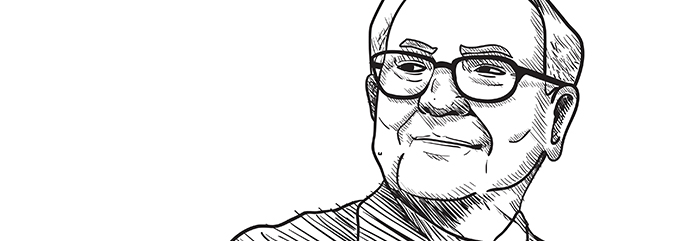In August 2020, Warren Buffett will celebrate his 90th birthday. As of his 89th birthday, he was the third-wealthiest individual on the planet with a net worth of over $80 billion.
He could be worth even more, if not for many years of charitable giving via his own foundation and donations to some of the biggest non-profit organisations on the planet – which we’ll come on to later.
The combination of age and personal wealth is no coincidence – Buffett has famously taken the slow road to his current portfolio over the course of a long and largely prosperous life.
His story is an example of how careful investment can reap dividends (literally) over the long term, and of how growth in a portfolio can compound over time to reach dizzying heights.
The Oracle of Omaha
Buffett has come to be known as the Oracle of Omaha, and that is where he was born, on August 30th 1930.
He is the middle child with two sisters, and his father Howard was a four-time US congressman and stockbroker.
It’s no surprise then that Buffett started his money-making endeavours relatively early in life, running a paper round and selling soft drinks.
By the age of 14, he had made enough to buy 40 acres of land and rent it out at a profit – it’s good to have land.
After completing his college education, Buffett returned to Omaha and joined his father’s firm, but was eventually hired in New York by Benjamin Graham, who he had studied under at Columbia.
In 1956 he returned to Omaha once again, this time to launch his own company, Buffett Associates Ltd, trading on a modified version of Graham’s theory of value investing.
Graham believed in investing in stocks that were trading at a much lower price than their intrinsic value; Buffett factored in the competitive advantage of the product and the way it was managed.
By 1962 he was a millionaire and linked up with Charlie Munger to form a partnership that developed Buffett’s theory further – and the two together purchased Berkshire Hathaway.
Trading in textiles
Berkshire Hathaway was a struggling textile mill and under Graham’s value investment theory, Buffett would have stripped it of any remaining value before shuttering the business.
In fact, it instead showed a chance of resurrection, and Buffett ended up using cash from the business to fund several other investments over the years.
Eventually in 1985, the textiles side of the business was closed down – but Buffett kept the name for his holding company, which is still the jewel in his crown to this day.
How to trade like Buffett
The underlying principles of Buffett’s approach to trading are simple. Focus on undervalued stocks and well-managed companies, and don’t plan to sell them.
His investments range from shares in household names like Coca-Cola and American Express, to outright buying companies like Dairy Queen and Fruit of the Loom.
In the 1990s, Buffett stayed out of the digital boom, having never been a great fan of technology, and while this initially attracted criticism from the investment community, it proved a prudent move when his profits soared after the dotcom bubble burst.
There’s a lesson for investors here – stick to what you know best. If you don’t know, understand or believe in the value of an investment, go with your gut.
A charitable legacy
Buffett hasn’t kept out of tech investment completely, and famously now owns a substantial quantity of shares in Apple, believing the iPhone to be significantly undervalued.
He also has a friendship with Microsoft founder Bill Gates, which he says is the reason why he does not invest in Microsoft, so as to avoid any accusations of insider info.
But that has not prevented him from establishing a more altruistic way to put funds into Gates’s activities.
In the summer of 2006, Buffett announced plans to donate a large amount of his personal wealth to the Bill & Melinda Gates Foundation.
The charity is one of the largest in the world and supports everything from libraries in the US to schools and health issues worldwide.
Buffett announced plans to donate shares from Berkshire Hathaway’s Class B stock holdings, in annual donations until his death.
As of 2019 he has given tens of billions of dollars to the foundation – increased further by appreciation in the stocks even after they were donated.
These contributions are a continuation of Buffett’s lifelong support of charities including half a century of charitable giving through the Susan Thompson Buffett Foundation, named in honour of his first wife.
Buffett is quoted as saying that he does not believe in “dynastic wealth” at the expense of billions of other humans who could benefit from that wealth during his remaining years.
Build it like Buffett
If you’d like your retirement years to be spent helping worthy causes – or you’d just like to retire with billions in the bank as soon as possible – Buffett’s life story is one worth knowing.
His vast personal wealth is a certain indicator that his approach to investing, at least during the 20th century and early 21st century, is a technique that reaps rewards over the long term.
In order to build your portfolio Buffett-style, remember the guiding principles:
- Invest in stocks that are underpriced compared to their intrinsic value.
- Focus on well-managed companies and competitive products.
- Don’t plan to sell, but hold on to your investments as they appreciate value.
Remember too that no matter how tempting an emerging market might seem in the short term, it’s sensible to resist it if you are not personally convinced.
In Buffett’s case that was the 1990s tech boom and especially the emergence of the internet and the dotcom bubble, which cost many other investors dearly.
As of 2019, the high level of volatility seen in cryptocurrencies is one comparable trend, and unless you intend to speculate in the short term (which flies in the face of the Buffett paradigm), you might think the risks outweigh the potential returns in cryptos.
Buffett’s ethos also serves as a reminder of a principle that many investors overlook: you don’t have to sell your best performing stocks.
Doing so weakens your overall portfolio, but Buffett’s track record is proof that by holding your strongest performers, you can build even greater wealth over time.
This is especially the case with stocks that pay reliable annual dividends, allowing you to derive an income from your investments, or reinvest for even greater appreciation.
Disclaimer: The information provided here is not investment, tax or financial advice. You should consult with a licensed professional for advice concerning your specific situation.




